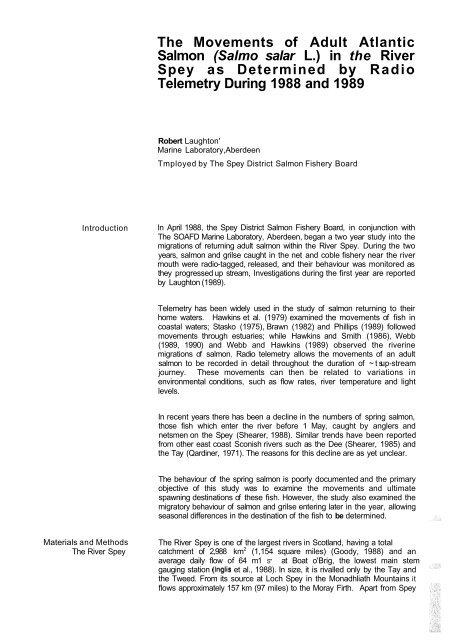( Salmo salar L.) in the River Spey as determined by
( Salmo salar L.) in the River Spey as determined by
( Salmo salar L.) in the River Spey as determined by
You also want an ePaper? Increase the reach of your titles
YUMPU automatically turns print PDFs into web optimized ePapers that Google loves.
The Movements of Adult Atlantic<br />
<strong>Salmo</strong>n (<strong>Salmo</strong> <strong>salar</strong> L.) <strong>in</strong> <strong>the</strong> <strong>River</strong><br />
<strong>Spey</strong> <strong>as</strong> Determ<strong>in</strong>ed <strong>by</strong> Radio<br />
Telemetry Dur<strong>in</strong>g 1988 and 1989<br />
Robert Laughton'<br />
Mar<strong>in</strong>e Laboratory,Aberdeen<br />
Tmployed <strong>by</strong> The <strong>Spey</strong> District <strong>Salmo</strong>n Fishery Board<br />
Introduction<br />
In April 1988, <strong>the</strong> <strong>Spey</strong> District <strong>Salmo</strong>n Fishery Board, <strong>in</strong> conjunction with<br />
The SOAFD Mar<strong>in</strong>e Laboratory, Aberdeen, began a two year study <strong>in</strong>to <strong>the</strong><br />
migrations of return<strong>in</strong>g adult salmon with<strong>in</strong> <strong>the</strong> <strong>River</strong> <strong>Spey</strong>. Dur<strong>in</strong>g <strong>the</strong> two<br />
years, salmon and grilse caught <strong>in</strong> <strong>the</strong> net and coble fishery near <strong>the</strong> river<br />
mouth were radio-tagged, rele<strong>as</strong>ed, and <strong>the</strong>ir behaviour w<strong>as</strong> monitored <strong>as</strong><br />
<strong>the</strong>y progressed up stream, Investigations dur<strong>in</strong>g <strong>the</strong> first year are reported<br />
<strong>by</strong> Laughton (1989).<br />
Telemetry h<strong>as</strong> been widely used <strong>in</strong> <strong>the</strong> study of salmon return<strong>in</strong>g to <strong>the</strong>ir<br />
home waters. Hawk<strong>in</strong>s et al. (1979) exam<strong>in</strong>ed <strong>the</strong> movements of fish <strong>in</strong><br />
co<strong>as</strong>tal waters; St<strong>as</strong>ko (1975), Brawn (1982) and Phillips (1989) followed<br />
movements through estuaries; while Hawk<strong>in</strong>s and Smith (1986), Webb<br />
(1989, 1990) and Webb and Hawk<strong>in</strong>s (1989) observed <strong>the</strong> river<strong>in</strong>e<br />
migrations of salmon. Radio telemetry allows <strong>the</strong> movements of an adult<br />
salmon to be recorded <strong>in</strong> detail throughout <strong>the</strong> duration of ~ts up-stream<br />
journey. These movements can <strong>the</strong>n be related to variations <strong>in</strong><br />
environmental conditions, such <strong>as</strong> flow rates, river temperature and light<br />
levels.<br />
In recent years <strong>the</strong>re h<strong>as</strong> been a decl<strong>in</strong>e <strong>in</strong> <strong>the</strong> numbers of spr<strong>in</strong>g salmon,<br />
those fish which enter <strong>the</strong> river before 1 May, caught <strong>by</strong> anglers and<br />
netsmen on <strong>the</strong> <strong>Spey</strong> (Shearer, 1988). Similar trends have been reported<br />
from o<strong>the</strong>r e<strong>as</strong>t co<strong>as</strong>t Sconish rivers such <strong>as</strong> <strong>the</strong> Dee (Shearer, 1985) and<br />
<strong>the</strong> Tay (Qard<strong>in</strong>er, 1971). The re<strong>as</strong>ons for this decl<strong>in</strong>e are <strong>as</strong> yet unclear.<br />
The behaviour of <strong>the</strong> spr<strong>in</strong>g salmon is poorly documented and <strong>the</strong> primary<br />
objective of this study w<strong>as</strong> to exam<strong>in</strong>e <strong>the</strong> movements and ultimate<br />
spawn<strong>in</strong>g dest<strong>in</strong>ations of <strong>the</strong>se fish. However, <strong>the</strong> study also exam<strong>in</strong>ed <strong>the</strong><br />
migratory behaviour of salmon and grilse enter<strong>in</strong>g later <strong>in</strong> <strong>the</strong> year, allow<strong>in</strong>g<br />
se<strong>as</strong>onal differences <strong>in</strong> <strong>the</strong> dest<strong>in</strong>ation of <strong>the</strong> fish to be determ<strong>in</strong>ed.<br />
Materials and Methods The <strong>River</strong> <strong>Spey</strong> is one of <strong>the</strong> largest rivers <strong>in</strong> Scotland, hav<strong>in</strong>g a total<br />
The <strong>River</strong> <strong>Spey</strong> catchment of 2,988 km 2 (1,154 square miles) (Goody, 1988) and an<br />
average daily flow of 64 m1 S" at Boat o'Brig, <strong>the</strong> lowest ma<strong>in</strong> stem<br />
gaug<strong>in</strong>g station (Inglis et al., 1988). In size, it is rivalled only <strong>by</strong> <strong>the</strong> Tay and<br />
<strong>the</strong> Tweed. From its source at Loch <strong>Spey</strong> <strong>in</strong> <strong>the</strong> Monadhliath Mounta<strong>in</strong>s it<br />
flows approximately 157 km (97 miles) to <strong>the</strong> Moray Firth. Apart from <strong>Spey</strong>
















